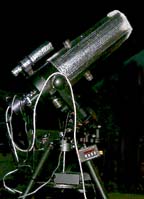

Celestron has replaced the C8 line with cost reduced variation called
the Celestar 8. The primary method of cost reduction was to combine the
wedge and tripod into a single (flimsy) unit they call a "wedgepod." While
the wedgepod may be cheaper, it is also nearly impossible to polar align.
It is my opinion that Celestron has taken a very functional entry level
telescope and ruined it for the sake of a few dollars in
retail price.
While I got a great deal of use a pleasure out of this C8+, I grew to
really dislike the fork mount. The very nature of its design makes it vibration
prone. I had the C8 Optical Tube Assembly (OTA) mounted for several months
on the GM8 mount shown below. When I returned the OTA to the fork mount,
I was appalled at the vibration level. It takes a great deal of effort
to get the axis orthogonal. There are parts of the sky that where one can
not do imaging because the camera hits the mount. If you are serious about
doing astroimaging, I suggest starting off with good German Equatorial
mount like the GM8